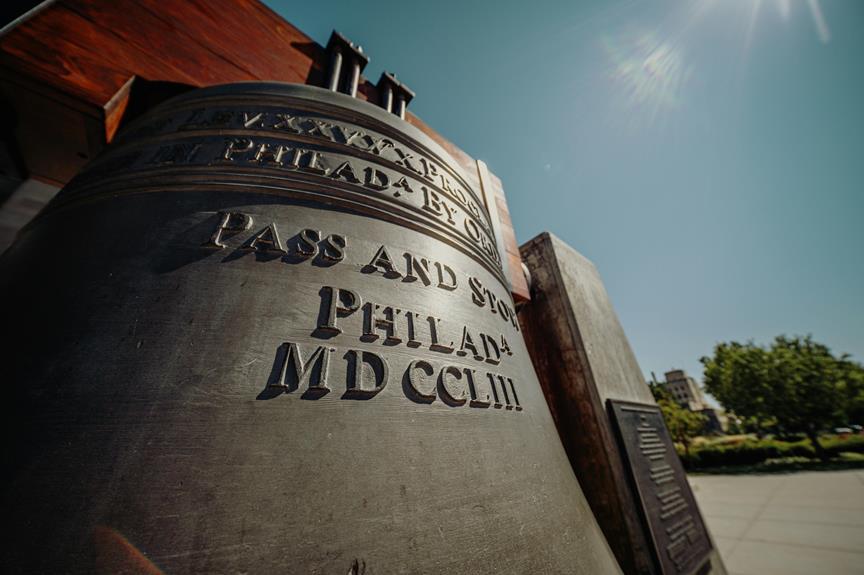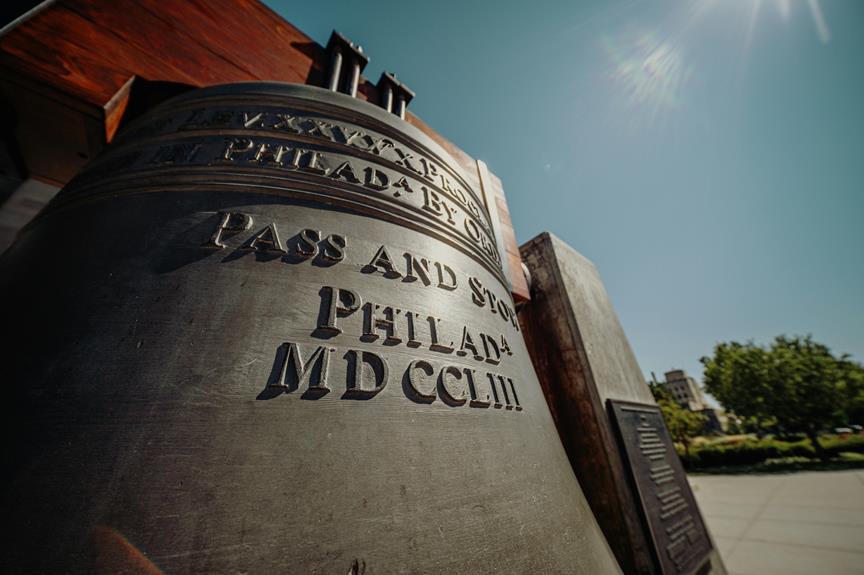The Hiroshima Peace Memorial, a poignant confirmation of the devastating impact of nuclear warfare, serves as a somber reminder of the atrocities of war and the resilience of the human spirit. Its stark silhouette against the sky beckons visitors to contemplate the enduring quest for peace amidst the shadows of history. As we explore the history, architecture, and symbolism of this iconic structure, we reveal layers of stories that echo through time, urging us to reflect on the past while shaping a future free from the horrors of war.
Key Takeaways
- Symbol of hope and peace after surviving atomic bombing.
- Blends Western and Eastern architecture with symbolic elements.
- Showcases survivors' stories and promotes peace education.
- Surrounded by peaceful gardens and art installations for reflection.
- Global symbol advocating for nuclear disarmament and human rights.
History of the Memorial
The Hiroshima Peace Memorial in Japan, also known as the Genbaku Dome, stands as a poignant reminder of the tragic events that unfolded on August 6, 1945. The origins of this iconic structure date back to its construction in 1915 as the Hiroshima Prefectural Commercial Exhibition Hall. The building's architectural style, influenced by European design trends of the time, gave it a unique presence in Hiroshima's landscape.
After the atomic bombing during World War II, the structure was one of the few left standing near the bomb's hypocenter, earning it the nickname 'A-Bomb Dome.' Its survival sparked controversy, with discussions on whether to preserve it as a memorial. Eventually, in 1966, the Hiroshima City Council designated it as a UNESCO World Heritage Site, recognizing its cultural significance and the need to preserve it as a symbol of peace and a declaration to the devastating power of nuclear weapons.
The Hiroshima Peace Memorial has had a profound cultural impact, drawing visitors from around the world to pay their respects and learn about the horrors of nuclear warfare. Despite initial controversy over its preservation, the Genbaku Dome now stands as a powerful symbol of hope, resilience, and the enduring pursuit of peace in a world still threatened by conflict.
Design and Architecture
With meticulous attention to detail and a blend of European design influences, the Hiroshima Peace Memorial, also known as the Genbaku Dome, showcases a unique architectural style that sets it apart in Hiroshima's landscape. The design and architecture of this memorial stand as a tribute to the resilience of the human spirit and the importance of remembrance.
Here are key points to note regarding the architectural marvels and cultural influences of the Hiroshima Peace Memorial:
- Western and Eastern Fusion: The architectural design of the Hiroshima Peace Memorial seamlessly blends Western and Eastern influences. While the structure reflects Western architectural elements such as the use of a dome, it also incorporates traditional Japanese design principles, creating a harmonious fusion of styles.
- Symbolism Through Design: Every aspect of the memorial's design carries deep symbolism. From the dome shape representing the desire for peace to the strategic placement of windows allowing sunlight to filter through, each detail conveys a poignant message of hope and remembrance.
- Minimalistic Elegance: The simplicity of the memorial's design is a deliberate choice to honor the memory of those who lost their lives in the atomic bombing. The minimalistic elegance of the structure evokes a sense of solemnity and contemplation, inviting visitors to reflect on the past while looking towards a peaceful future.
Significance and Symbolism
Incorporating profound symbolism and historical significance, the Hiroshima Peace Memorial stands as a poignant reminder of the enduring impact of war and the collective pursuit of peace. The symbolic representation of the memorial lies in its dual nature – as a tribute to the lives lost in the atomic bombing of Hiroshima and as a beacon of hope for a peaceful future. The memorial's architectural design, with its skeletal structure and exposed dome, serves as a powerful symbol of resilience and serves as a solemn reminder of the destructive power of war.
| Symbolism | Cultural Significance |
|---|---|
| A-Bomb Dome | International Peace |
| Cranes | Japanese Resilience |
| Flame of Peace | Global Solidarity |
| Cenotaph | Remembrance |
The A-Bomb Dome, the most iconic feature of the memorial, stands as a stark reminder of the devastation caused by the atomic bomb. The origami cranes, often left at the Children's Peace Monument, symbolize the hope for peace and serve as a tribute to Sadako Sasaki and the thousands of child victims of the bombing. The Flame of Peace, kept burning until the world is free from nuclear weapons, represents global solidarity in the pursuit of peace. To conclude, the Cenotaph, inscribed with the words 'Let all the souls here rest in peace, for we shall not repeat the evil,' serves as a place of remembrance for the victims and a call for a peaceful future. The cultural significance of these symbols resonates not only in Japan but worldwide, emphasizing the importance of preserving peace and preventing such tragedies from happening again.
Survivors' Stories
Symbolism and historical significance intertwine at the Hiroshima Peace Memorial, leading us to the profound narratives of survivors who witnessed the devastating aftermath of the atomic bombing. These survivors' stories provide a firsthand account of the impact of war and the resilience of the human spirit in the face of unimaginable tragedy.
- Impact: The survivors' stories vividly depict the immediate and long-term effects of the atomic bombing on Hiroshima. From the initial shockwaves and destruction to the subsequent health issues and emotional scars, these accounts highlight the profound impact that nuclear warfare had on the city and its inhabitants.
- Resilience: Despite facing immense adversity, the survivors' stories also showcase the resilience and strength of the human spirit. Through their accounts of rebuilding their lives, advocating for peace, and finding hope amidst despair, these individuals inspire readers to believe in the power of perseverance and compassion.
- Legacy: The survivors' stories form an essential part of Hiroshima's legacy, reminding future generations of the horrors of war and the importance of working towards a peaceful world. Their narratives serve as a poignant reminder of the need to work towards a future free from nuclear threats and conflict, where the lessons of the past are not forgotten.
Peace Park Surroundings
The landscaping surrounding the Hiroshima Peace Park complements the memorial's somber atmosphere with serene gardens and tranquil pathways. Nature integration is a key element in the design, with carefully curated green spaces that provide visitors with a sense of peace and reflection. The park features meditation spaces where visitors can sit quietly, contemplate, and pay their respects to the victims of the atomic bombing.
In addition to the natural elements, the Peace Park surroundings also incorporate art installations and public art pieces that further enhance the visitor experience. These installations serve as poignant reminders of the importance of peace and reconciliation in a world scarred by conflict. The integration of art into the park's landscape adds a layer of depth and contemplation to the overall atmosphere.
Visitors to the Peace Park can wander through the carefully manicured gardens, taking in the beauty of the surroundings while reflecting on the tragic events that took place in Hiroshima. The peaceful ambiance of the park encourages quiet contemplation and remembrance, creating a space for visitors to connect with history and honor the memory of the victims. The combination of nature, art, and tranquility in the park's surroundings makes it a poignant and powerful destination for those seeking to pay their respects and promote peace.
Annual Commemorative Events
Annual commemorative events at the Hiroshima Peace Memorial play a significant role in honoring the memory of the atomic bombing victims. These events not only commemorate the lives lost but also promote peace, unity, and the prevention of such tragedies in the future.
- Peace Ceremonies:
One of the central aspects of the annual commemorative events is the solemn peace ceremonies held at the memorial. These ceremonies bring together survivors, families of the victims, government officials, and international delegates to offer prayers, reflect on the impact of the atomic bombing, and renew commitments to peace.
- Cultural Performances:
In addition to the formal ceremonies, cultural performances are organized to pay tribute to the victims and promote cultural exchange. These performances, ranging from traditional Japanese music and dance to contemporary art forms, serve as a reminder of the resilience of the human spirit and the power of art in healing and reconciliation.
- Guest Lectures and Workshops:
Another integral part of the annual commemorative events is the inclusion of guest lectures, seminars, and workshops on topics related to peace, nuclear disarmament, and the consequences of war. Experts, scholars, and activists from around the world come together to share knowledge, insights, and strategies for building a more peaceful and secure future.
Educational Programs Offered
Educational programs offered at the Hiroshima Peace Memorial serve as essential tools for fostering understanding, promoting peace education, and raising awareness about the impact of nuclear warfare. These programs are designed to engage visitors in interactive workshops that encourage active participation and critical thinking. Through a variety of educational initiatives, the memorial aims to create a space where individuals can learn about the devastating consequences of nuclear weapons and the importance of working towards a peaceful world.
One of the key components of the educational programs at the Hiroshima Peace Memorial is the emphasis on cultural exchanges. By facilitating interactions between people from different backgrounds, these programs promote dialogue, empathy, and mutual respect. Participants have the opportunity to engage with survivors of the atomic bombing, hear their stories firsthand, and gain a deeper understanding of the human cost of war.
Through these educational programs, visitors are encouraged to reflect on the past, contemplate the present, and envision a future free from the threat of nuclear destruction. By fostering a sense of global citizenship and responsibility, the Hiroshima Peace Memorial plays an important role in shaping attitudes towards peace and conflict resolution. Through interactive workshops and cultural exchanges, the memorial continues to inspire individuals to work towards a more just and peaceful world.
Impact on Global Consciousness
A significant transformation in global consciousness regarding the impact of nuclear warfare has been observed as a result of the Hiroshima Peace Memorial's efforts. The memorial stands as a poignant reminder of the devastating consequences of the atomic bomb dropped on Hiroshima during World War II, sparking vital conversations and actions around the world. This transformation is evident through various aspects:
- Nuclear disarmament and peace movements: The Hiroshima Peace Memorial has played a pivotal role in advocating for nuclear disarmament and fostering peace movements globally. By highlighting the catastrophic effects of nuclear weapons, the memorial has spurred initiatives aimed at preventing future use of such weapons and promoting peaceful resolutions to conflicts.
- Recognition of war atrocities: Through its exhibitions and educational programs, the memorial has contributed to raising awareness about war atrocities and the importance of upholding human rights. Visitors are confronted with the harsh realities of war, fostering empathy and understanding towards victims of violence and conflict.
- Promotion of human rights: The Hiroshima Peace Memorial has become a symbol of the universal struggle for human rights. It serves as a platform for promoting tolerance, reconciliation, and respect for the dignity of all individuals, emphasizing the need for global solidarity in preserving peace and justice.
Preservation and Restoration Efforts
The ongoing preservation and restoration efforts of the Hiroshima Peace Memorial play a vital role in safeguarding its historical significance and ensuring its enduring message resonates with future generations. Preservation challenges faced by the memorial include environmental factors such as exposure to sunlight, rain, and humidity, which can lead to deterioration of the structure and materials. Additionally, the memorial is at risk of natural disasters like earthquakes, which pose a threat to its physical integrity.
To combat these preservation challenges, innovative restoration techniques are employed. One such technique is the use of advanced materials that are durable and resistant to environmental factors, helping to prolong the lifespan of the memorial. Regular inspections and maintenance work are also carried out to detect any signs of damage early on and address them promptly.
Restoration efforts focus not only on physical preservation but also on maintaining the authenticity and integrity of the memorial. Historical research plays a crucial role in ensuring that any restoration work is in line with the original design and purpose of the memorial.
Visitor Information and Tips
Visitor information and tips regarding the Hiroshima Peace Memorial provide essential guidance for individuals seeking to explore this significant historical site in Japan. Situated in Hiroshima, Japan, the Peace Memorial serves as a vital reminder of the devastating impact of nuclear warfare and stands as a symbol of peace and hope for a world free from such atrocities.
- Cultural Etiquette: When visiting the Hiroshima Peace Memorial, it is important to observe and respect the cultural norms and traditions of Japan. Visitors should dress modestly, remove their shoes when entering certain areas, and maintain a respectful demeanor throughout their visit.
- Nearby Attractions: After exploring the Hiroshima Peace Memorial, visitors can further enrich their experience by visiting nearby attractions. One such site is the Hiroshima Peace Memorial Park, where the iconic A-Bomb Dome stands as a UNESCO World Heritage Site. Additionally, the Hiroshima Peace Memorial Museum offers in-depth exhibits detailing the events of the atomic bombing and its aftermath, providing valuable historical context to visitors.
- Travel Tips: To make the most of a visit to the Hiroshima Peace Memorial, it is advisable to allocate sufficient time to explore the various exhibits and monuments. Additionally, visitors should consider purchasing a guidebook or audio tour to enhance their understanding of the site's significance and history.
Frequently Asked Questions
How Has the Local Community Been Involved in the Maintenance of the Hiroshima Peace Memorial?
Community involvement in preservation efforts is crucial for sustaining historical sites. Collaborative initiatives engage locals in maintaining the heritage's integrity and relevance. By inviting residents to participate in upkeep tasks, such as cleaning, fundraising, and guiding visitors, a sense of ownership and responsibility is fostered.
This active engagement guarantees that the site's significance is appreciated and protected for future generations, creating a sustainable model for cultural preservation.
Are There Any Specific Guidelines for Visitors to Pay Their Respects at the Memorial?
When considering visitors' conduct at a memorial site, it is essential to adhere to specific guidelines that respect the cultural significance of the location.
These guidelines may include maintaining a solemn demeanor, refraining from disruptive behavior, and following any specific rules set by the memorial's administration.
What Measures Are in Place to Protect the Memorial From Natural Disasters?
Natural disaster preparedness at historic sites involves strategic planning to mitigate risks. Conservation efforts safeguard against potential damages that could compromise the integrity of the memorial.
Thorough measures such as structural reinforcements, early warning systems, and regular maintenance play vital roles in protection. Collaborations with relevant authorities and ongoing assessments guarantee the resilience of the site against natural calamities.
Vigilance and proactive initiatives are essential in safeguarding these significant landmarks for future generations.
How Has the Memorial Influenced Contemporary Art and Literature?
In the world of contemporary art and literature, the Hiroshima Peace Memorial exerts a profound influence on creative expressions. Its symbolic significance and historical impact have inspired artists and writers to explore themes of resilience, peace, and cultural reflection.
Through creative endeavors, the memorial's message transcends boundaries, shaping cultural narratives and fostering a deeper understanding of the human experience in the face of adversity.
Can Visitors Participate in Any Volunteer Activities at the Peace Park?
Volunteer opportunities at significant historical sites are essential for community involvement.
Many visitors seek to contribute through various activities such as guiding tours, assisting with maintenance, or participating in educational programs.
These volunteer opportunities not only enhance the visitor experience but also foster a sense of ownership and responsibility towards preserving the site for future generations.
Active community involvement guarantees the continued relevance and sustainability of these important landmarks.
Conclusion
To sum up, the Hiroshima Peace Memorial stands as a steadfast beacon of hope and remembrance, embodying the resilience of those affected by nuclear warfare. Its significance transcends borders and time, serving as a poignant reminder of the devastation caused by the atomic bomb.
Through its blend of Western and Eastern architectural influences, the memorial symbolizes the universal pursuit of peace and the importance of never forgetting the lessons of history.


